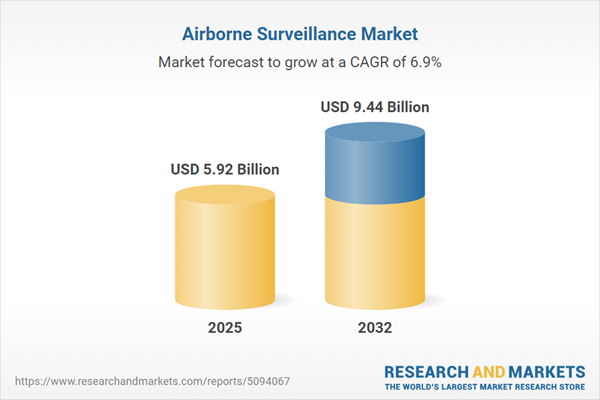Speak directly to the analyst to clarify any post sales queries you may have.
Senior decision-makers are intensifying their investments in airborne surveillance market solutions to achieve better operational oversight and risk management amid evolving regulatory and security challenges. Leveraging advanced real-time monitoring and actionable intelligence, organizations across multiple sectors are adapting their strategies for compliance and streamlined incident response.
Market Snapshot: Airborne Surveillance Market Overview
The airborne surveillance market is showing stable growth, with a current market value of USD 5.54 billion in 2024, expected to reach USD 5.92 billion by 2025 and further projected to expand to USD 9.44 billion by 2032, reflecting a CAGR of 6.87%. Several factors contribute to this momentum, including increasing adoption of high-resolution sensors, expanding deployment of signals intelligence technologies, and the growing reliance on unmanned aerial vehicles (UAVs) across public safety, defense, and commercial domains. As global regulations shift, organizations now prioritize rapid access to robust, real-time data for informed decision-making and refined strategic planning, ensuring adaptability in unpredictable market conditions.
Scope & Segmentation of the Airborne Surveillance Market
- Platform Types: Both manned aircraft and UAVs offer operational flexibility for missions such as public safety, industrial asset management, emergency response, and regulatory compliance efforts. Their adaptability supports rapid reconfiguration for different sector demands.
- System Types: Technologies including LiDAR, radar, electro-optical infrared, communications systems, and electronic intelligence solutions enable collection and analysis of critical data. These systems serve government agencies, industrial operators, and agricultural enterprises with tools suited for diverse operational needs.
- Applications: Reconnaissance, border and maritime security, disaster response, agricultural surveying, infrastructure inspections, and transportation oversight are core application areas. Each supports enhanced situational awareness and operational control tailored to specific sector priorities.
- End Users: Civil aviation authorities, law enforcement organizations, commercial operators, homeland security agencies, and agricultural businesses rely on airborne surveillance to improve workflow, manage risk, and strengthen compliance with ever-evolving regulations.
- Geographic Coverage: The market serves the Americas, Europe, Middle East, Africa, and Asia-Pacific. Adoption varies regionally due to local technology priorities, regulatory frameworks, and sector-specific requirements, influencing solution customization and deployment strategies.
- Leading Companies: Key providers such as Lockheed Martin, Northrop Grumman, The Boeing Company, General Atomics Aeronautical Systems, L3Harris, Leonardo S.p.A., Thales, Airbus SE, Elbit Systems, and Saab AB maintain a competitive edge through ongoing innovation and diverse offerings. These organizations supply specialized solutions to both defense and commercial clients worldwide.
Key Takeaways for Senior Decision-Makers
- Integrating diverse sensors within airborne surveillance systems raises operational agility, facilitating rapid adaptation to varied mission requirements and distinct sector challenges.
- Ongoing collaboration with technology partners and continuous attention to compliance help sustain resilient supply chains and support sustained operations during dynamic shifts in the business climate.
- Leveraging UAVs with modular architectures enables organizations to scale and tailor surveillance capabilities to evolving sector-specific objectives, supporting efficient capability upgrades.
- Adopting open system architectures ensures readiness for technology advancements, allowing seamless integration of new solutions and maintaining regulatory alignment for future operational needs.
- Custom solutions tailored for sectors such as agriculture and infrastructure translate to targeted process improvements, enhancing organizational efficiency and sharpening focus on mission-critical goals.
Tariff Impact: Adapting to US Trade Policy Changes
As US tariffs and trade regulations evolve, market participants emphasize domestic manufacturing, transparent sourcing, and rigorous compliance protocols. These measures aim to protect business continuity and sustain competitiveness in a complex trade environment while meeting emerging policy expectations.
Methodology & Data Sources
This report builds on a thorough review of recognized industry publications, regulatory documentation, and recent technical literature. Insights are further validated by direct interviews with sector experts and structured surveys across targeted industry segments. This rigorous methodology ensures up-to-date and accurate coverage of the airborne surveillance market for strategic planning.
Why This Report Matters: Strategic Value for Senior Leaders
- Presents actionable market analysis to support identification of new opportunities and refinement of entry strategies responsive to evolving industry needs.
- Enables proactive responses to shifting regulatory and operational pressures, reinforcing risk management strategies and bolstering organizational agility.
- Keeps leadership informed about current technology trends and relevant geopolitical shifts, supporting informed resource allocation and effective competitive positioning.
Conclusion
Innovation in airborne surveillance continues to underpin advances in compliance and better risk management. This report supports executive leadership in making strategic decisions that enhance readiness and drive operational success amid a changing landscape.
Additional Product Information:
- Purchase of this report includes 1 year online access with quarterly updates.
- This report can be updated on request. Please contact our Customer Experience team using the Ask a Question widget on our website.
Table of Contents
3. Executive Summary
4. Market Overview
7. Cumulative Impact of Artificial Intelligence 2025
Companies Mentioned
The companies profiled in this Airborne Surveillance market report include:- Lockheed Martin Corporation
- Northrop Grumman Corporation
- The Boeing Company
- General Atomics Aeronautical Systems, Inc.
- L3Harris Technologies, Inc.
- Leonardo S.p.A.
- Thales S.A.
- Airbus SE
- Elbit Systems Ltd.
- Saab AB
Table Information
| Report Attribute | Details |
|---|---|
| No. of Pages | 193 |
| Published | October 2025 |
| Forecast Period | 2025 - 2032 |
| Estimated Market Value ( USD | $ 5.92 Billion |
| Forecasted Market Value ( USD | $ 9.44 Billion |
| Compound Annual Growth Rate | 6.8% |
| Regions Covered | Global |
| No. of Companies Mentioned | 11 |









